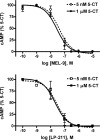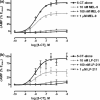The arylpiperazine derivatives N-(4-cyanophenylmethyl)-4-(2-diphenyl)-1-piperazinehexanamide and N-benzyl-4-(2-diphenyl)-1-piperazinehexanamide exert a long-lasting inhibition of human serotonin 5-HT7 receptor binding and cAMP signaling
- PMID: 25505568
- PMCID: PMC4186431
- DOI: 10.1002/prp2.13
The arylpiperazine derivatives N-(4-cyanophenylmethyl)-4-(2-diphenyl)-1-piperazinehexanamide and N-benzyl-4-(2-diphenyl)-1-piperazinehexanamide exert a long-lasting inhibition of human serotonin 5-HT7 receptor binding and cAMP signaling
Abstract
We performed a detailed in vitro pharmacological characterization of two arylpiperazine derivatives, compound N-(4-cyanophenylmethyl)-4-(2-diphenyl)-1-piperazinehexanamide (LP-211) previously identified as a high-affinity brain penetrant ligand for 5-hydroxytryptamine (serotonin) type 7 (5-HT7) receptors, and its analog N-benzyl-4-(2-diphenyl)-1-piperazinehexanamide (MEL-9). Both ligands exhibited competitive displacement of [(3)H]-(2R)-1-[(3-hydroxyphenyl)sulfonyl]-2-[2-(4-methyl-1-piperidinyl)ethyl]pyrrolidine ([(3)H]-SB-269970) radioligand binding and insurmountable antagonism of 5-carboxamidotryptamine (5-CT)-stimulated cyclic adenosine monophosphate (cAMP) signaling in human embryonic kidney (HEK293) cells stably expressing human 5-HT7 receptors. They also inhibited forskolin-stimulated adenylate cyclase activity in 5-HT7-expressing HEK293 cells but not in the parental cell line. The compounds elicited long-lasting (at least 24 h) concentration-dependent inhibition of radioligand binding at 5-HT7-binding sites in whole-cell radioligand binding assays, after pretreatment of the cells with the compounds and subsequent compound removal. In cAMP assays, pretreatment of cells with the compounds rendered 5-HT7 receptors unresponsive to 5-CT and also rendered 5-HT7-expressing HEK293 cells unresponsive to forskolin. Compound 1-(2-biphenyl)piperazine (RA-7), a known active metabolite of LP-211 present in vivo, was able to partially inhibit 5-HT7 radioligand binding in a long-lasting irreversible manner. Hence, LP-211 and MEL-9 were identified as high-affinity long-acting inhibitors of human 5-HT7 receptor binding and function in cell lines. The detailed in vitro characterization of these two pharmacological tools targeting 5-HT7 receptors may benefit the study of 5-HT7 receptor function and it may lead to the development of novel selective pharmacological tools with defined functional properties at 5-HT7 receptors.
Keywords: HEK293 cells; LP-211; Schild analysis; [3H]-SB-269970 binding; arylpiperazine derivative; cAMP signaling; insurmountable antagonism; irreversible inhibition; long-lasting inhibition; preincubation/washout experiments; serotonin 5-HT7 receptors.
Figures








Similar articles
-
Decreased agonist, but not antagonist, binding to the naturally occurring Thr92Lys variant of the h5-HT7(a) receptor.Neurochem Int. 2005 Aug;47(3):196-203. doi: 10.1016/j.neuint.2005.03.003. Neurochem Int. 2005. PMID: 15896881
-
Structural modifications of the serotonin 5-HT7 receptor agonist N-(4-cyanophenylmethyl)-4-(2-biphenyl)-1-piperazinehexanamide (LP-211) to improve in vitro microsomal stability: A case study.Eur J Med Chem. 2016 Sep 14;120:363-79. doi: 10.1016/j.ejmech.2016.05.005. Epub 2016 May 6. Eur J Med Chem. 2016. PMID: 27318552
-
Allosteric Inhibition of Serotonin 5-HT7 Receptors by Zinc Ions.Mol Neurobiol. 2018 Apr;55(4):2897-2910. doi: 10.1007/s12035-017-0536-0. Epub 2017 Apr 28. Mol Neurobiol. 2018. PMID: 28455702 Free PMC article.
-
Structure-affinity relationship study on N-(1,2,3,4-tetrahydronaphthalen-1-yl)-4-aryl-1-piperazinealkylamides, a new class of 5-hydroxytryptamine7 receptor agents.J Med Chem. 2004 Dec 16;47(26):6616-24. doi: 10.1021/jm049702f. J Med Chem. 2004. PMID: 15588097
-
Functional characterisation of the human cloned 5-HT7 receptor (long form); antagonist profile of SB-258719.Br J Pharmacol. 1998 Jul;124(6):1300-6. doi: 10.1038/sj.bjp.0701946. Br J Pharmacol. 1998. PMID: 9720804 Free PMC article.
Cited by
-
Targeting the Serotonin 5-HT7 Receptor in the Search for Treatments for CNS Disorders: Rationale and Progress to Date.CNS Drugs. 2015 Apr;29(4):265-75. doi: 10.1007/s40263-015-0236-0. CNS Drugs. 2015. PMID: 25721336 Free PMC article. Review.
-
Grape seed powder increases gastrointestinal motility.Int J Med Sci. 2022 May 21;19(5):941-951. doi: 10.7150/ijms.72529. eCollection 2022. Int J Med Sci. 2022. PMID: 35693751 Free PMC article.
-
International Union of Basic and Clinical Pharmacology. CX. Classification of Receptors for 5-hydroxytryptamine; Pharmacology and Function.Pharmacol Rev. 2021 Jan;73(1):310-520. doi: 10.1124/pr.118.015552. Pharmacol Rev. 2021. PMID: 33370241 Free PMC article. Review.
-
(S)-5-(2'-Fluorophenyl)-N,N-dimethyl-1,2,3,4-tetrahydronaphthalen-2-amine, a Serotonin Receptor Modulator, Possesses Anticonvulsant, Prosocial, and Anxiolytic-like Properties in an Fmr1 Knockout Mouse Model of Fragile X Syndrome and Autism Spectrum Disorder.ACS Pharmacol Transl Sci. 2020 Feb 21;3(3):509-523. doi: 10.1021/acsptsci.9b00101. eCollection 2020 Jun 12. ACS Pharmacol Transl Sci. 2020. PMID: 32566916 Free PMC article.
References
-
- Adriani W, Travaglini D, Lacivita E, Saso L, Leopoldo M, Laviola G. Modulatory effects of two novel agonists for serotonin receptor 7 on emotion, motivation and circadian rhythm profiles in mice. Neuropharmacology. 2012;62:833–842. - PubMed
-
- Andressen KW, Norum JH, Levy FO, Krobert KA. Activation of adenylyl cyclase by endogenous G(s)-coupled receptors in human embryonic kidney 293 cells is attenuated by 5-HT(7) receptor expression. Mol Pharmacol. 2006;69:207–215. - PubMed
-
- Bonaventure P, Dugovic C, Kramer M, De Boer P, Singh J, Wilson S, et al. Translational evaluation of JNJ-18038683, a 5-hydroxytryptamine type 7 receptor antagonist, on rapid eye movement sleep and in major depressive disorder. J Pharmacol Exp Ther. 2012;342:429–440. - PubMed
-
- Brenchat A, Romero L, García M, Pujol M, Burgueño J, Torrens A, et al. 5-HT7 receptor activation inhibits mechanical hypersensitivity secondary to capsaicin sensitization in mice. Pain. 2009;141:239–247. - PubMed
LinkOut - more resources
Full Text Sources
Other Literature Sources

